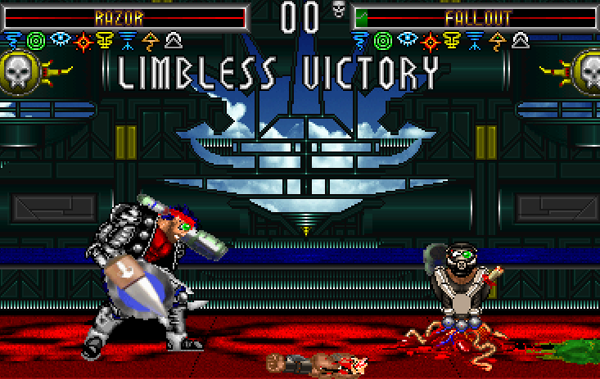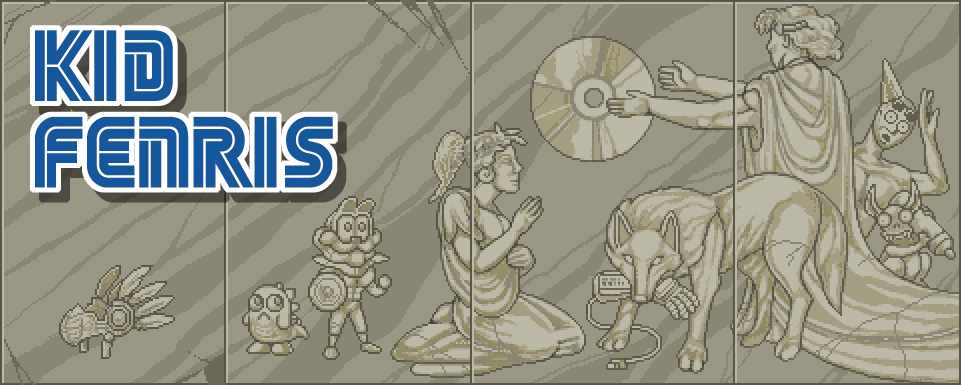Yes, that BloodStorm. Strata’s 1994 arcade fighter that tried to outdo Mortal Kombat in the worst way. Staged in a post-apocalyptic hellscape, BloodStorm allows all of its hideously stereotyped characters to decapitate, dismember, and disembowel each other during combat. It remains the rare game where a halved warrior will scoot across the floor upon a pile of entrails, undeterred by the absence of legs or arms. You can still win a match like that. It's awful and hilarious.

I liked BloodStorm a lot. Part of it was indeed the relentless carnage, the willingness to get as gruesome and vicious as mid-1990s arcades would allow. Yet I also latched on to the game’s legitimate innovations. It had a remarkable amount of things to discover: hidden levels, secret characters, warps, and a series of “taunts” that showed up on-screen when you mashed buttons after a victory. BloodStorm also let players gain a new ability from each defeated opponent, and these powers could be stored in the arcade unit with a password system. Too bad BloodStorm wasn’t in arcades for all that long.
BloodStorm didn’t really stick around, and I was outraged at this. It led me to do something I’d never done before: I wrote a fan letter to a game company. In the years that followed, I would write several more (usually regarding some RPG that would never be released in the U.S.), but my BloodStorm gushery came first. And I got a better response than I ever expected.

I received a very nice form letter thanking me for my “kind words about BloodStorm.” At least, I assume it’s a form letter; it does get a bit specific about the game’s reception. If it is a form letter, Scott Morrison of Incredible Technologies (the company behind Strata) was rather forthcoming about BloodStorm’s chances in the arcade industry. Of course, I took his advice and nagged my local arcades about bringing back BloodStorm. It didn’t work.
Mr. Morrison was also generous in what he sent with the letter: the BloodStorm handbook, a tip sheet for finding the hidden agents, and a six-page list of codes that was marked “CONFIDENTIAL: STRATA & IT EMPLOYEES ONLY.” I was awestruck by this. There were codes to play as the bosses, codes for every taunt, codes to change characters post-match, and codes to unlock “big head” characters (including Senator Joe Lieberman, then notorious for his crusade against violent games). I was reluctant to share this privileged information at first, for fear that I’d be sued. Of course, today the entire code list is online, and I don't think anyone got arrested over it.
I was equally fascinated by the Official BloodStorm Handbook, which details the movelists and backstories for the characters. You can read the handbook's content at the link above. Be sure not to miss the fact that man-hating warrior queen Mirage lives in the “Obsel” desert. Someone thought that was clever.
Any extant BloodStorm fans will note that some of the background material isn’t mentioned in the game itself, including the ill-fated romance between Princess Tempest and the cyborg pirate Razor. He’s handsome and crafty.

The letter suggests that I “watch for the home version on many of the new systems this Christmas.” BloodStorm was slated for the PlayStation and Saturn by GameTek, but neither version would surface. Perhaps Time Killers, BloodStorm’s predecessor, didn’t do well enough on the Genesis. Perhaps the publisher balked at porting an arcade flop, and a fairly controversial one at that.

EGM2 ran a vague preview of the Saturn and PlayStation versions. Or so I assume. It’s hard to tell if those are actual console screenshots or just low-resolution caps of the arcade version, and it raises the question of just how far along the BloodStorm port actually got. A lot of canceled games are just daydreams, press releases, and notebook scrawls.
Without a second chance on a home system, BloodStorm drifted away, and everyone involved moved on. Incredible Technologies shut down the Strata label, and the company found success with Golden Tee Golf and other bar-game attractions. In fact, Scott Morrison is now their vice president of marketing. Actor Daniel Pesina parted ways with the Mortal Kombat games, appeared in a BloodStorm ad, and seems to be doing well. BloodStorm artist Luis Mangubat and programmer Alan Noon (who mentions the game in his Street Fighter: The Movie retrospective) went to Midway. The Simpsons unintentionally referenced BloodStorm in a Christmas episode. And me? I grew up, found other fighting games, and looked back on BloodStorm in this now-outdated column.
Even now, I have some appreciation for BloodStorm. As tasteless as it may be in every conceivable manner, there are good ideas beneath the eviscerated mutants and decapitated amazons. The passable powers and manifold secrets are rather creative for a 1994 fighter, and it might’ve succeeded had it arrived before Mortal Kombat II provoked a glut of imitators. At the very least, there was a lot for violence-addled brats like me to discover. BloodStorm didn’t do much in the vast scope of the arcade industry, but it made a young and dumb fighting-game fan feel important.

The letter suggests that I “watch for the home version on many of the new systems this Christmas.” BloodStorm was slated for the PlayStation and Saturn by GameTek, but neither version would surface. Perhaps Time Killers, BloodStorm’s predecessor, didn’t do well enough on the Genesis. Perhaps the publisher balked at porting an arcade flop, and a fairly controversial one at that.

EGM2 ran a vague preview of the Saturn and PlayStation versions. Or so I assume. It’s hard to tell if those are actual console screenshots or just low-resolution caps of the arcade version, and it raises the question of just how far along the BloodStorm port actually got. A lot of canceled games are just daydreams, press releases, and notebook scrawls.
Without a second chance on a home system, BloodStorm drifted away, and everyone involved moved on. Incredible Technologies shut down the Strata label, and the company found success with Golden Tee Golf and other bar-game attractions. In fact, Scott Morrison is now their vice president of marketing. Actor Daniel Pesina parted ways with the Mortal Kombat games, appeared in a BloodStorm ad, and seems to be doing well. BloodStorm artist Luis Mangubat and programmer Alan Noon (who mentions the game in his Street Fighter: The Movie retrospective) went to Midway. The Simpsons unintentionally referenced BloodStorm in a Christmas episode. And me? I grew up, found other fighting games, and looked back on BloodStorm in this now-outdated column.
Even now, I have some appreciation for BloodStorm. As tasteless as it may be in every conceivable manner, there are good ideas beneath the eviscerated mutants and decapitated amazons. The passable powers and manifold secrets are rather creative for a 1994 fighter, and it might’ve succeeded had it arrived before Mortal Kombat II provoked a glut of imitators. At the very least, there was a lot for violence-addled brats like me to discover. BloodStorm didn’t do much in the vast scope of the arcade industry, but it made a young and dumb fighting-game fan feel important.

Wow! This one really brings me back. I too loved this game in the arcade, and much like your situation, it wasn't around long. I recall groups of kids sitting around the machine, watching the gory demo when they were out of quarters. Fine memories, indeed.
ReplyDelete